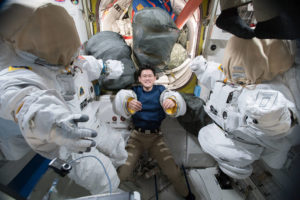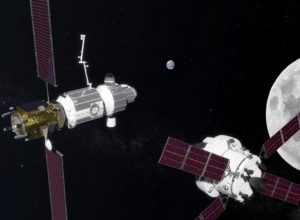NASA needs textile manufacturing partners to support the success of future missions.

While NASA still has its sights set on a Mars mission in the 2030s, a more imminent project is in the works. The Deep Space Gateway is a joint project between the U.S. and Russia to build a miniature space station in lunar orbit, intended to be a gateway to enable human spaceflight missions to Mars and other planets.
“I envision different partners, both international and commercial, contributing to the gateway and using it in a variety of ways with a system that can move to different orbits to enable a variety of missions,” says William Gerstenmaier, associate administrator for Human Exploration and Operations at NASA, as quoted on NASA.gov. “The gateway could move to support robotic or partner missions to the surface of the moon, or to a high lunar orbit to support missions departing from the gateway to other destinations in the solar system.”
And as in every mission since Project Mercury, the first human spaceflight program of the U.S., textiles will play a crucial part in the success and survival of the mission and its astronauts. “There are always changes in new programs and the way we have to proceed, and we adjust,” says Evelyne Orndoff, M.S., senior textiles engineer at NASA Johnson Space Center, Houston, Texas. “The priority doesn’t change, however. Logistics Reduction is needed for exploration of deep space. Logistics Reduction basically speaks to the mass and volume of everything we launch. It’s not just textiles; but it’s also everything for long-duration missions for which we don’t have resupply vessels.”
Orndoff and her team are focusing on everyday clothing the astronauts will wear, which have very specific requirements. In addition to mass and volume limitations, clothing textiles need to address the perennial problems of odor, lint and fire retardancy and melt.
Self-cleaning technology
“Mars and deep Space missions mean that every ounce is even more valuable so the need is for low mass textiles that still achieve the same functional requirements,” says Lucy Dunne, Ph. D., associate professor and director, Apparel Design Program, co-director, Wearable Technology Lab, Department of

Design, Housing and Apparel, University of Minnesota. “For clothing, re-usability and refreshing is one important aspect, and because the astronauts are not able to wash the clothes, self-cleaning and non-liquid cleaning methods are an interesting possibility.”
Although the type of cleaning technology necessary for long-duration missions doesn’t yet exist, universities are working toward it. Dunne’s students work on semester-long NASA projects each year, and for the spring 2017 semester engaged in clothing refreshing projects. “These are short-term projects through a teaching mechanism,” Dunne says. “Two student groups developed separate methods of cleaning clothing, and both had good results. One was a UV-based technique and the other was adsorption-based. Both used antimicrobial textiles to reduce the development of odors.”
Natural fibers revisited
Until textile cleaning technology for long-duration missions is a reality, Orndoff and her team are continuing to look for textile materials that a crew can wear for extended periods of time without laundering. Among those fabrics are cotton and wool. “Wool is consistently giving good results, and some of our international partners have used wool for a long time,” she says. “We’re particularly interested Merino wool, which isn’t as bothersome as are many other wools.”
Technological developments in the cotton industry are affecting the quality of these fibers and fabrics. “The cotton we’re looking at now is not the cotton we used before,” Orndoff says. “We are evaluating cotton fibers that have gone through processes different from the traditional methods.”
The retail certification problem
NASA currently uses retail products in addition to custom materials but all materials require detailed documentation and certification that are very time consuming and costly to the space programs. “We buy some finished goods, such as a certain type of t-shirt or shorts and we go through the documentation and certification process to make sure they’re suitable for space exploration use,” Orndoff says. “The problem is that often the product changes somewhat over time, which requires us to recertify them, even though they may be very similar to the previous products. The stakes are high. The astronauts’ survival may be dependent on some change in the new products—but doing all the paperwork again is very burdensome to the government.”
The concern is similar for chemicals that can be used to refresh clothing. The chemicals may be effective in refreshing clothing or being perceived as fresh, but outgassing can be a safety risk for the astronauts. “There may be something coming out of those materials, such as particulates that you don’t see but could be toxic—we’re talking life support for the astronauts,” Orndoff says.
In search of partners
Although Orndoff and her team are searching for fibers and fabrics that meet the specific needs of deep space exploration, the bigger hurdle for them may be their need for textile manufacturers who will partner with them for the long haul. “At times we find vendors who are willing to work with us. They see something that is a technology interesting to them, but they end up feeling we are working so slowly that together we will not have a product developed soon enough. Where these partnerships have worked has been when companies have been patient, perseverant, flexible and accepting of the ways the government and NASA do business.”
Orndoff says that although NASA is not bound by the Berry Amendment as is the DoD, it tries to use U.S.-based vendors for its projects. “We’ve been approached by companies not based in the U.S. that are willing to work with us to develop what we need,” she says. “Working with a foreign company without a U.S. subsidiary is very complicated and takes additional time. Sometimes it’s not worth the effort.
“And I wonder: where are the American companies?” she continues. “There are opportunities here for companies that are patient and perseverant and willing to work within the government’s ways of doing things.”
Sigrid Tornquist is associate editor of InTents, an IFAI publication, and contributes regularly to other IFAI publications, including Advanced Textiles Source.
 TEXTILES.ORG
TEXTILES.ORG


